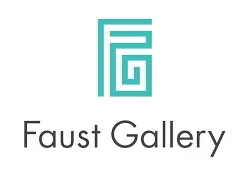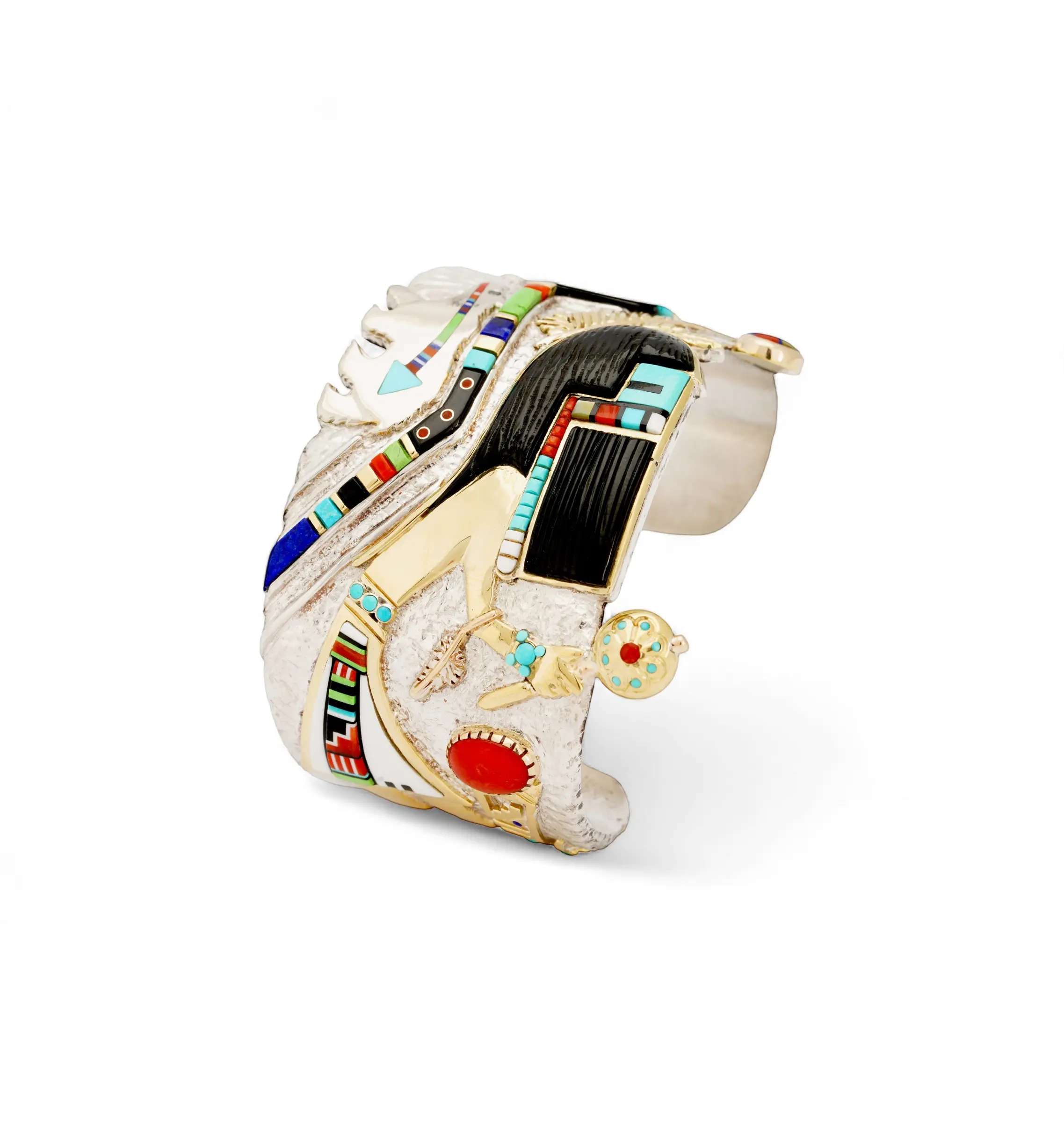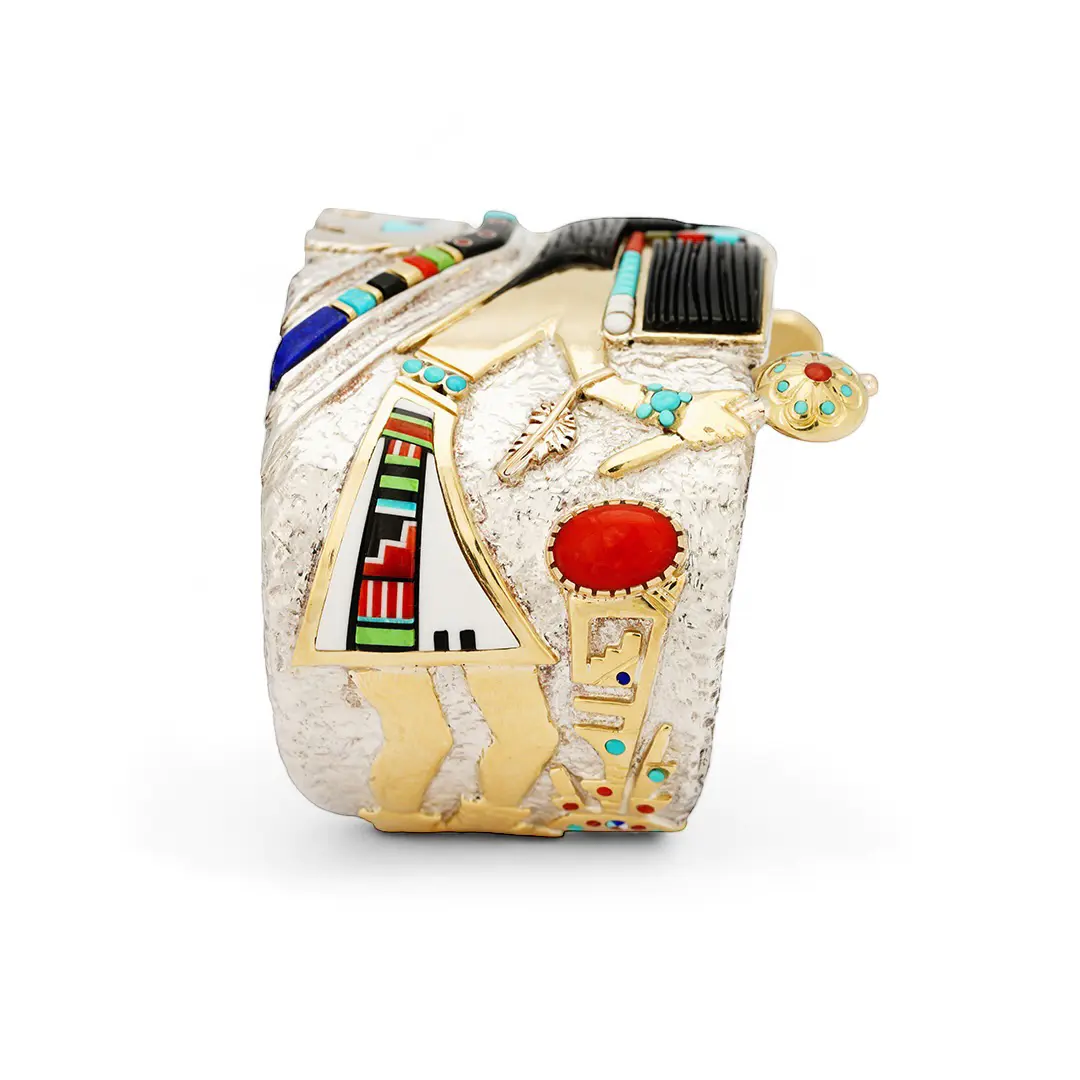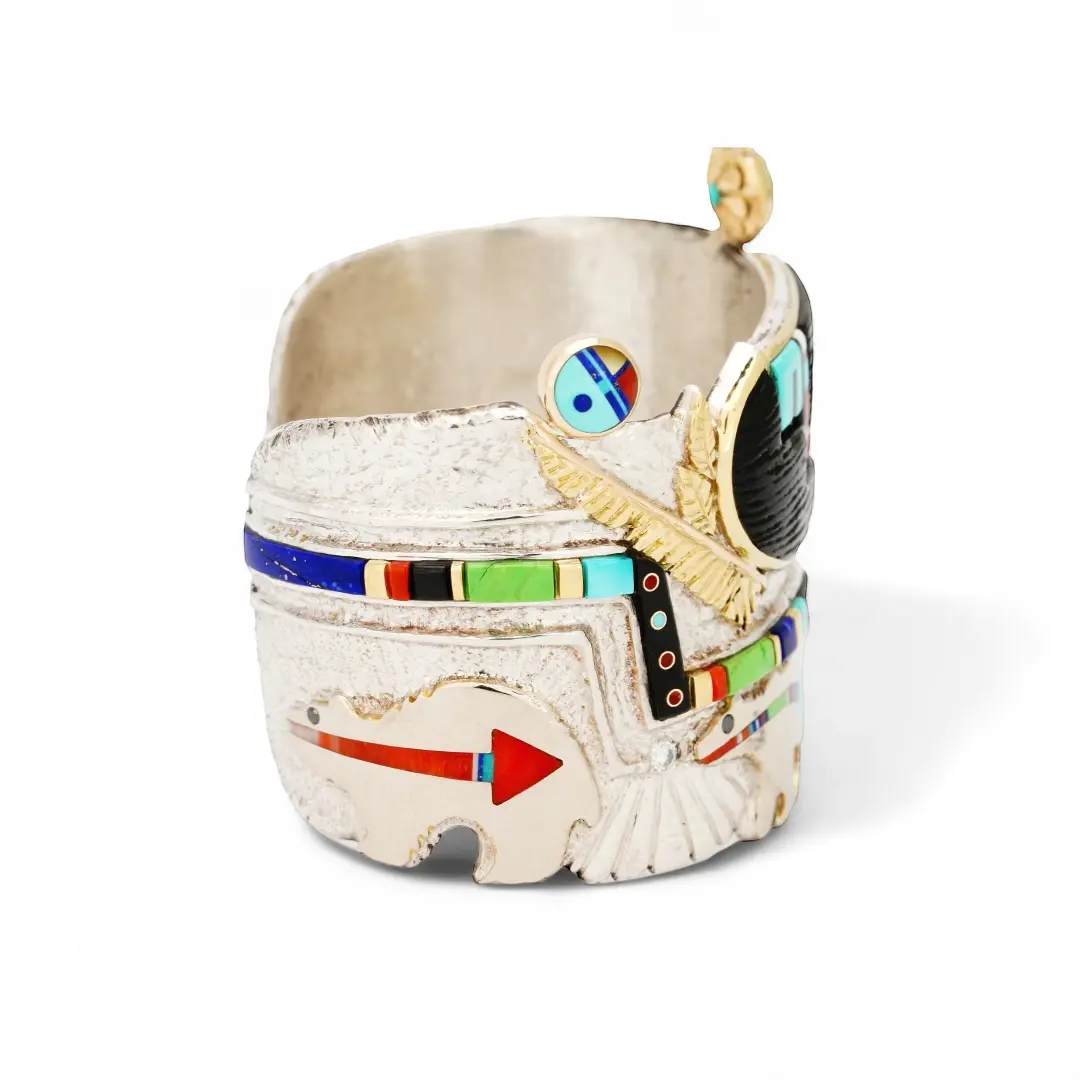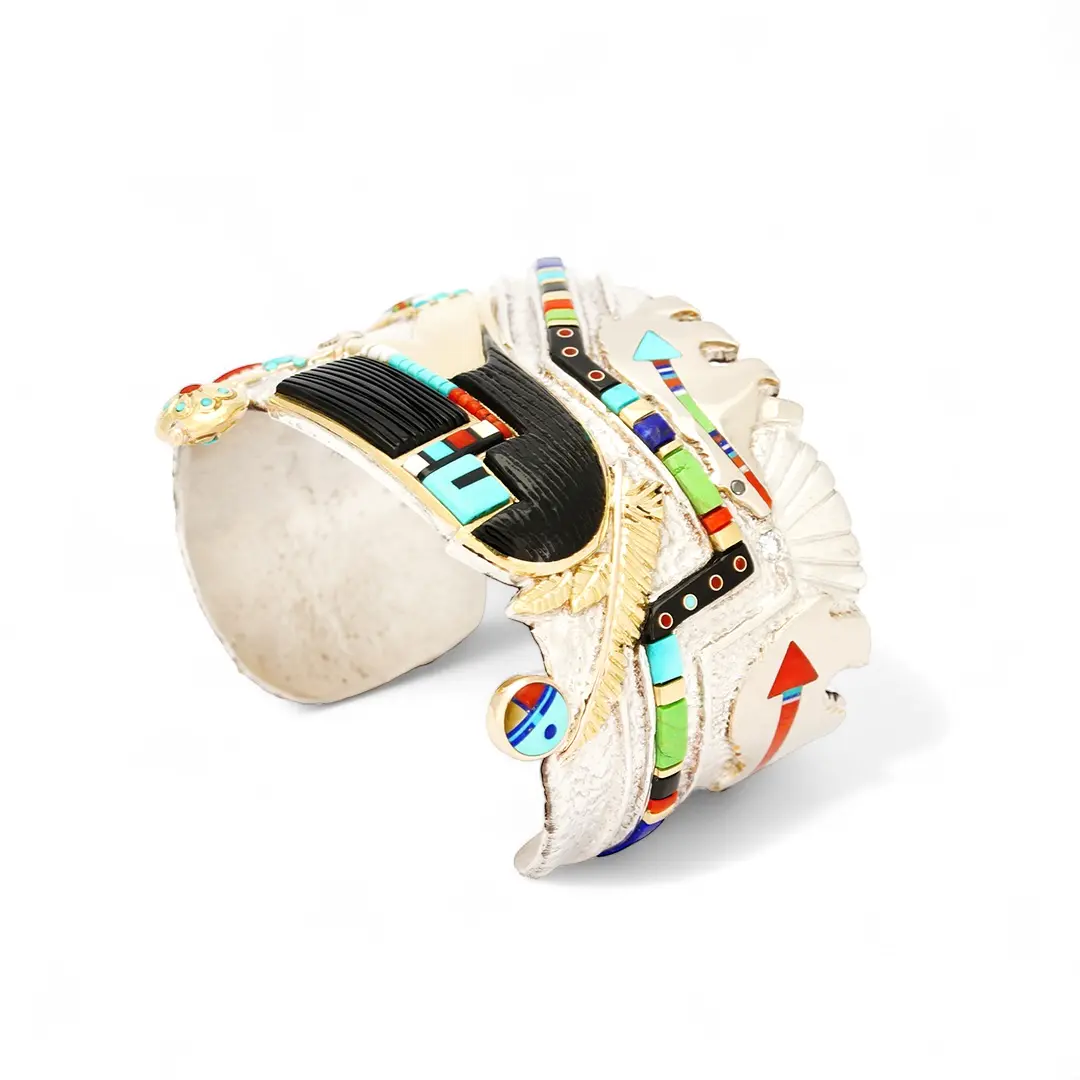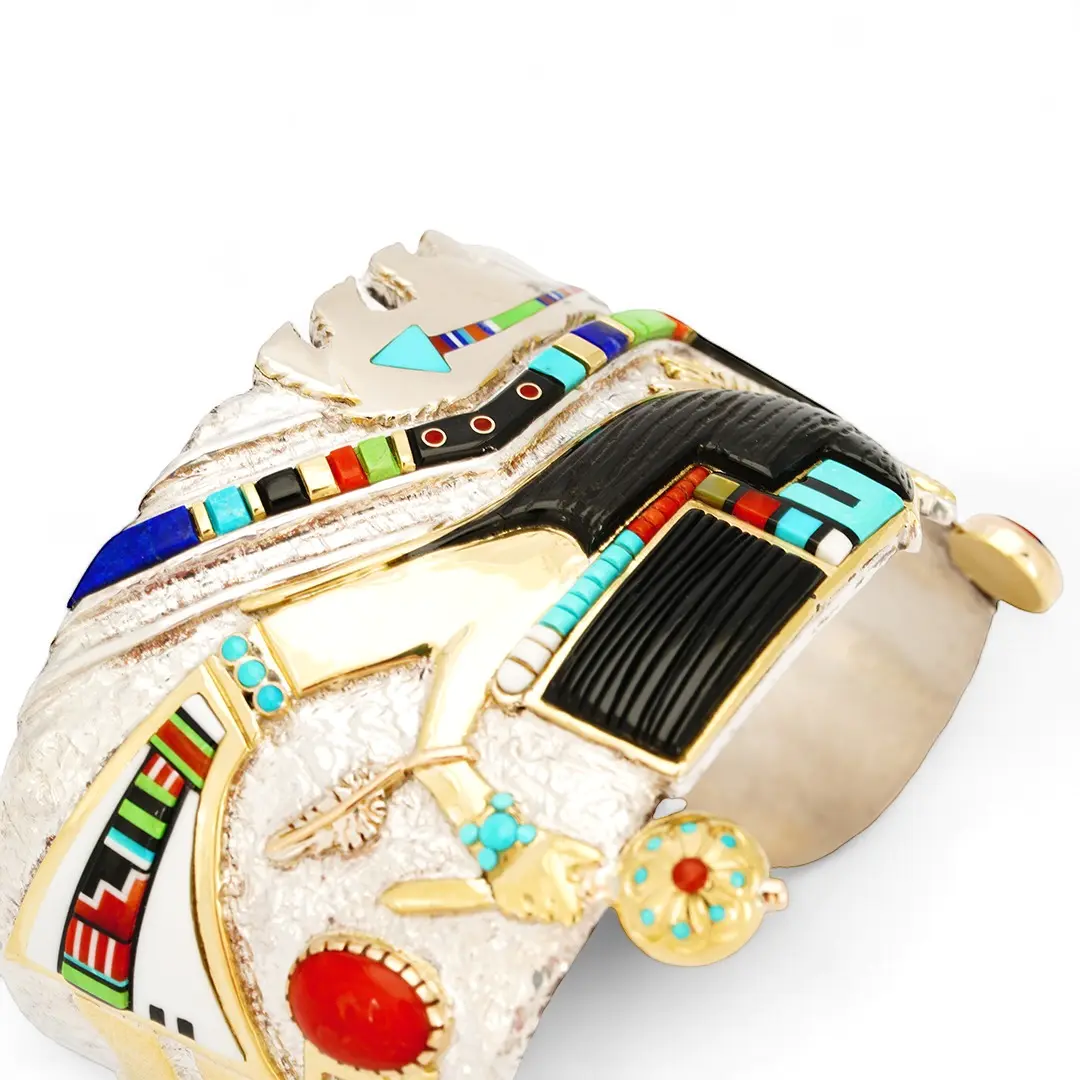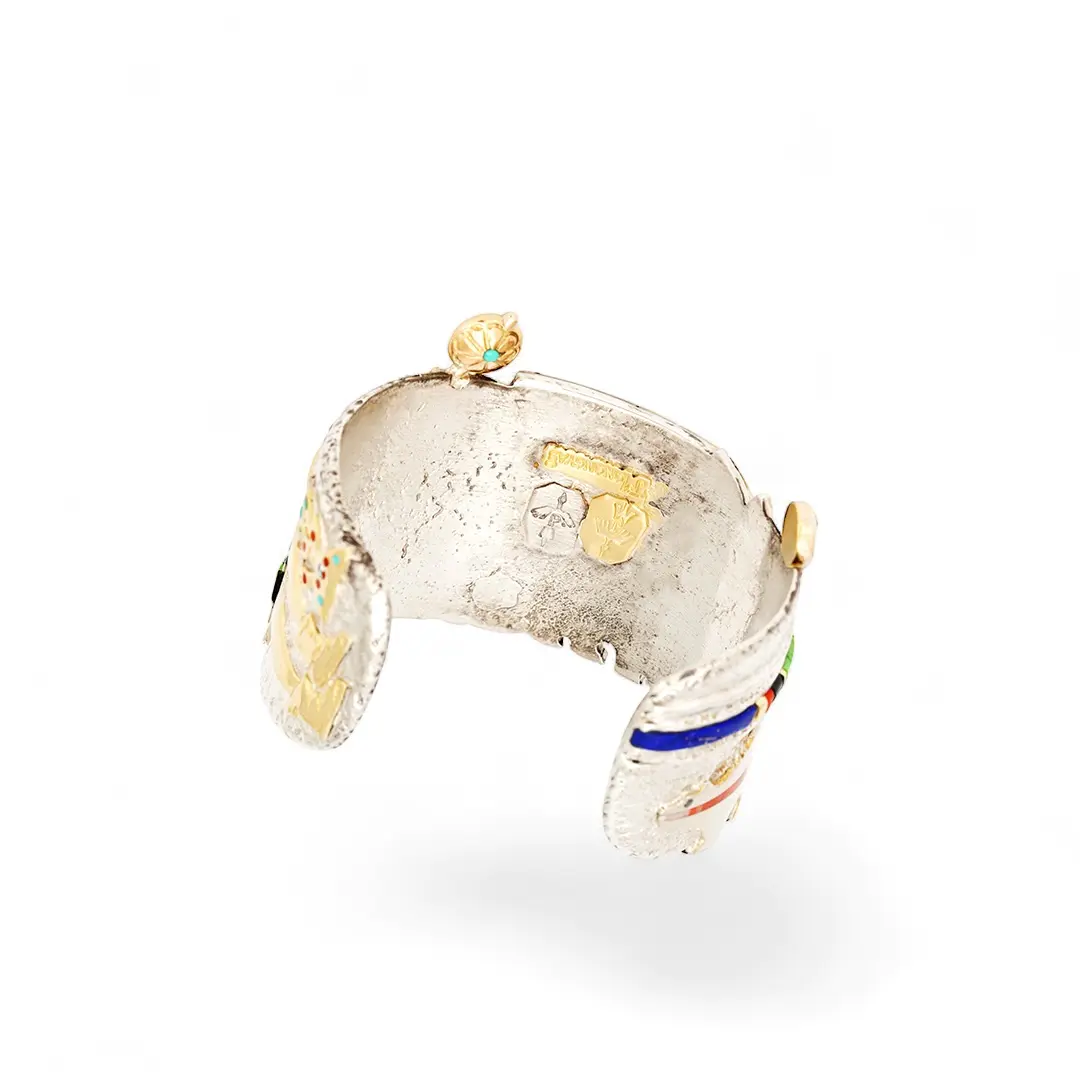Monongye, Preston + Monongya, Jesse + Monongye, Bo Long Hair Kachina Inlaid Bracelet
This rare sterling silver and 14k gold bracelet is a three-generation collaboration by Preston Monongye, his son Jesse Monongya, and grandson Bo Monongye—uniting a family legacy of innovation and craftsmanship. Honoring the Long Hair Kachina (Angak’china)—a spirit of rain, harmony, and renewal in Hopi tradition—the bracelet features flowing hand-carved black jade hair, a 14k gold rattle that extends beyond the silver casting, and a traditional dancer’s kilt inlaid with turquoise, coral, shell, and jet. Framed by vibrant inlay and two heart-line bears, symbols of life force and strength, this museum-quality piece embodies motion, symbolism, and the enduring spirit of generational artistry.
Dimensions: 2 taper to 1 5/8 th
Bracelet Size: 5
Bracelet Opening: 1″ 1/8th
POR
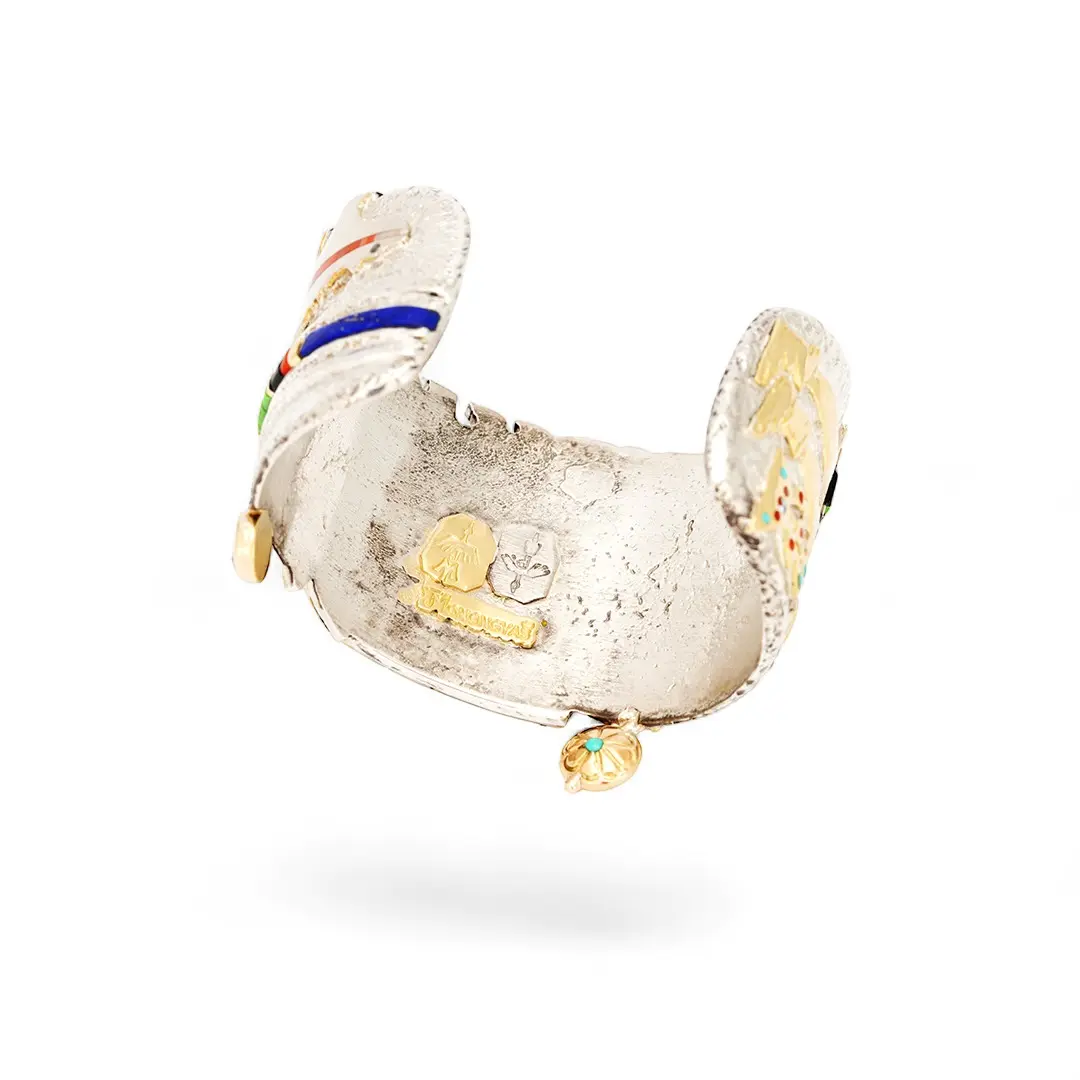
- The Monongye Family
- About Preston Monongye
- About Jesse Monongya
- Bracelet Description
- Bracelet Sizing Guide
PRESTON MONONGYE
Preston Monongye (1927–1987) was a pioneering force in the “New Indian Jewelry” movement of the 1960s and 70s. Born in Los Angeles and abandoned at Hopi at the age of seven, he was adopted by a prominent Hopi family and fully immersed in Hopi religious and cultural life. At nine years old, he began apprenticing with his uncle, the renowned silversmith and painter Gene Pooyama. After serving as a paratrooper in World War II, Monongye worked as a Kachina painter and took occasional jobs with Roman Hubbell and the Fred Harvey Company. He later re-enlisted for the Korean War and worked in law enforcement for the Bureau of Indian Affairs, continuing to paint and make jewelry during that time.
In the early 1960s, he left government work to pursue jewelry full-time and quickly gained recognition for his innovative approach, merging traditional Hopi techniques with a bold, contemporary vision. He became especially known for his tufa cast silver set with stones cut by Lee Yazzie and later by his son, Jesse Monongya. A dedicated teacher and respected voice in Native design, Monongye taught at workshops and lectured across the country.
Jesse Monongya – Master Jeweler of Navajo and Hopi Heritage
1952–2024
Jesse Monongya was a celebrated Native American jeweler of Navajo and Hopi descent, widely known for his extraordinary inlay work and symbolic, sculptural designs. Born in Phoenix, Arizona, in 1952, he was raised by Navajo relatives in the Chuska Mountains near Two Grey Hills, New Mexico, after being abandoned at a young age. His early life was shaped by deep cultural traditions and spiritual teachings, which later informed his artistry.
A turning point in his life came in 1975, when Monongya reunited with his biological father—renowned Hopi jeweler Preston Monongye. Under his father’s mentorship, Jesse began refining his craft, combining Hopi-inspired design sensibilities with Navajo symbolism and a unique vision all his own.
Monongya’s work is best known for its cosmic themes and masterful stone-to-stone inlay technique. Using materials such as lapis lazuli, turquoise, coral, opal, and fossilized ivory, he created wearable landscapes, spiritual motifs, and celestial symbols. His signature bear pendants, symbolizing strength and protection, became some of his most iconic creations. These intricately inlaid bears often featured stars and planetary elements set against jet or dark backgrounds, evoking the cosmos.
His career spanned decades, during which he earned numerous awards, including Best of Show at the Inter-Tribal Indian Ceremonial in Gallup and Best of Division at Santa Fe Indian Market. His work has been collected and exhibited by leading institutions such as the Heard Museum, the Smithsonian National Museum of the American Indian, and the Museum of Modern Art.
Jesse Monongya passed away in Scottsdale, Arizona, on August 6, 2024, at the age of 71. He is remembered not only for his artistic mastery but also for the spiritual depth and cultural richness embedded in each of his creations. His legacy lives on through his influence on younger generations of Native American jewelers, including his own children and apprentices.
Texture
From the hand-carved flowing jet hair to the intricate micro inlay, every element captures the motion and spirit of the dance. A standout feature is the gold rattle, which extends beyond the edge of the textured sterling silver lost wax casting, inlaid on both sides with natural coral and turquoise stones.
Kachina Hand- Fabricated in 14k Gold
Shown on this bracelet, an inlaid set in 14k gold, the dancer wears a traditional-style kilt inlaid with turquoise, coral, shell, and jet, symbolizing the spiritual traditions of American Indians. His outstretched arms and detailed regalia, formed in gold and inlay, evoke both motion and reverence.
Detail Inlaid
Framing the dancer is a row of inlay set with lapis, turquoise, coral, jet, and fine gold accents, along with two inlaid heart-line bears — powerful symbols of life force and strength in Native tradition.
Bracelet Sizing Guide: How to Measure Your Wrist for the Perfect Fit
Choosing the right bracelet size is essential for both comfort and style. Whether you’re purchasing a cuff or a link design, our simple guide below will help you measure your wrist accurately and find the ideal fit.
Step-by-Step: How to Measure Your Wrist
You only need a flexible measuring tape, a strip of paper, or a string.
Option 1: Using a Flexible Measuring Tape
- Wrap the tape snugly around your wrist just above the wrist bone (the area where you would normally wear a watch).
- Note the measurement in inches or centimeters.
- This is your wrist size.
Option 2: Using a String or Strip of Paper
- Wrap the string or paper around your wrist in the same location (above the wrist bone).
- Mark the point where the string overlaps.
- Lay the string flat and measure it with a ruler.
- This is your wrist size.
Choosing the Right Fit
Different bracelet styles may fit differently. Here’s a general guideline based on the style of bracelet:
Cuff Bracelets (Non-Adjustable)
Cuffs should fit snugly but comfortably. We recommend adding 1/4″ to 1/2″ to your wrist measurement depending on your desired fit:
- Snug Fit: Add 1/4″
- Comfort Fit: Add 1/2″
Example: If your wrist measures 6″, a cuff bracelet that is 6 1/4″ to 6 1/2″ total (including the opening) would be ideal.
Chain or Link Bracelets
For flexible bracelets with clasps:
- Add 1/2″ to 3/4″ to your wrist measurement for a comfortable fit.
- A looser fit can be achieved by adding up to 1 inch.
Faust Gallery Bracelet Size Chart
| Wrist Size (inches) | Recommended Bracelet Size (cuff or chain) |
|---|---|
| 5.5″ | 6″ – 6.25″ |
| 6″ | 6.5″ – 6.75″ |
| 6.5″ | 7″ – 7.25″ |
| 7″ | 7.5″ – 7.75″ |
| 7.5″ | 8″ – 8.25″ |
| 8″ | 8.5″ – 8.75″ |
Note: Cuff sizes include both the inner circumference and the opening.
Helpful Tips
- If you’re in between sizes, choose the larger size for comfort.
- Keep in mind that handmade cuffs often cannot be resized due to the materials and techniques used—accurate sizing is essential.
- Feel free to contact us if you’re unsure. We’re happy to help you find the right fit for any piece.
Still Unsure? We’re Here to Help.
At Faust Gallery, we’re committed to ensuring your bracelet fits beautifully. If you need personalized guidance, don’t hesitate to reach out to us at sales@faustgallery.com or visit us in Scottsdale or Santa Fe for an in-person fitting.
